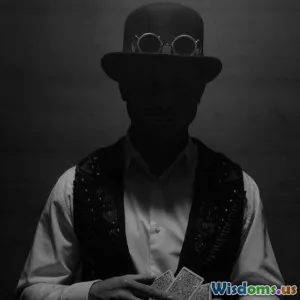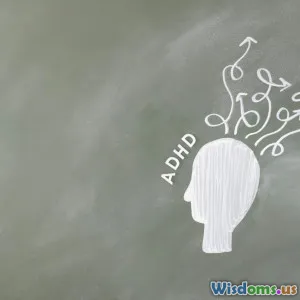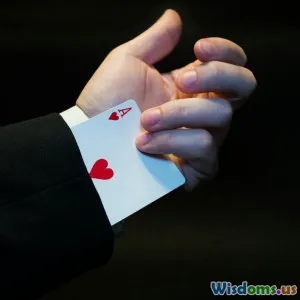
Magic Tricks That Stunned Audiences Worldwide
6 min read Explore mind-blowing magic tricks that amazed audiences globally with secrets, history, and unforgettable performances. (0 Reviews)
Magic Tricks That Stunned Audiences Worldwide
Magic has captivated humanity for centuries, blending mystery, performance, and psychology into experiences that defy explanation. Whether in ancient temples or modern theaters, certain magic tricks transcend time and culture, leaving audiences spellbound. This article explores some of the most astonishing magic tricks that have stunned spectators around the world and uncovers what makes these illusions legendary.
Introduction: The Everlasting Allure of Magic
Magic’s power lies in its seamless manipulation of perception. When performed masterfully, illusions can awaken genuine wonder—challenging what we believe possible. Audiences from all walks of life have been enthralled by magicians who combine showmanship with ingenious techniques, creating moments that appear to bend reality.
But why do certain tricks remain etched in collective memory long after the curtain falls? The perfect blend of storytelling, timing, precision, and mystery transports viewers beyond the ordinary.
Iconic Magic Tricks That Captivated the Globe
Houdini’s Death-Defying Escapes
Harry Houdini, arguably the most famous magician of the early 20th century, revolutionized stage magic through his death-defying escape acts. Among his most notable was the Water Torture Cell, where Houdini was suspended upside-down in a locked glass tank filled with water. The audience held their breath as he struggled to free himself before running out of air.
This trick was a masterclass in suspense and showmanship, leveraging physical skill and preparation to create an illusion of imminent doom. Audiences worldwide tuned in to marvel at Houdini’s seemingly impossible feats, inspiring countless performers that followed.
David Copperfield’s Walking Through the Great Wall of China
Fast forward to the late 20th century, David Copperfield pushed illusion into grand narratives. In 1986, he astounded the world by walking through the Great Wall of China, a feat broadcast globally.
This trick combined intricate engineering with performance art. Copperfield employed cleverly concealed openings and expert camera work to sell the illusion convincingly. The spectacle underscored how technology and storytelling can amplify traditional magic, producing moments that feel cinematic in scale.
Siegfried & Roy’s White Tigers Vanish
Known for combining magic with exotic animals, Siegfried & Roy’s stage show delivered moments of awe and wonder. One standout trick involved making their famed white tigers vanish in the blink of an eye.
This illusion relied on impeccable timing and lighting design alongside traditional sleight of hand and misdirection. Beyond technical brilliance, it tapped into the awe of nature and power—engaging emotions to deepen the impact.
Dynamo’s Walking on Water
In contemporary magic, Dynamo brought street-level illusions to massive audiences with acts like walking on the River Thames in London.
This trick used glass panels strategically concealed beneath the water’s surface and camera angles that obscured any seams. It demonstrated how modern magicians blend live performance with digital media-savvy techniques to generate viral moments that resonate worldwide.
The Science and Psychology Behind Magic
The art of magic is rooted firmly in human perception and cognition. Tricks like these exploit fundamental psychological phenomena:
- Misdirection: Diverting the audience’s focus away from secret moves. For instance, a magician’s flamboyant gesture often masks a sleight of hand.
- Gestalt Principles: Our brain’s tendency to perceive whole shapes or patterns leads us to complete illusions where reality is incomplete.
- Memory Manipulation: Magicians use repetitive cues and suggestion to plant false memories, enhancing mystery.
A 2011 study in the Journal of Neuroscience revealed that observing magic engages brain areas involved in conflict detection and resolution, explaining why viewers experience amazement and cognitive dissonance.
Cultural Impact and Legacy
Legendary magic acts have influenced not just entertainment but popular culture, literature, and film. Houdini inspired numerous escape artist narratives; Copperfield redefined live spectacle; Dynamo and modern magicians harness social media to spread magic’s allure globally.
Magic continues to evolve, incorporating holograms and augmented reality, but the classics endure because of their timeless ability to inspire awe.
Conclusion: Why These Tricks Endure
Magic’s magnificence lies in its timeless question: "How?" Tricks like Houdini’s escapes or Copperfield’s Chinese Wall subvert natural laws compellingly. They weave together technique, narrative, and psychology, delivering experiences that are not just performances but shared moments of wonder.
For spectators and magicians alike, these illusions symbolize the power of imagination and human ingenuity—reminding us that sometimes, the most profound mysteries are those waiting just beyond our understanding.
Interested in experiencing magic firsthand? Attend a live magic show or explore resources on sleight of hand and performance psychology. The world of illusions awaits your wonder!
Rate the Post
User Reviews
Popular Posts



















